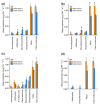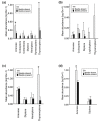Herbivory and Attenuated UV Radiation Affect Volatile Emissions of the Invasive Weed Calluna vulgaris
- PMID: 32668802
- PMCID: PMC7397131
- DOI: 10.3390/molecules25143200
Herbivory and Attenuated UV Radiation Affect Volatile Emissions of the Invasive Weed Calluna vulgaris
Abstract
Calluna vulgaris (heather) is an aggressive invasive weed on the Central Plateau, North Is., New Zealand (NZ), where it encounters different environmental factors compared to its native range in Europe, such as high ultraviolet radiation (UV) and a lack of specialist herbivores. The specialist herbivore Lochmaea suturalis (heather beetle) was introduced from the United Kingdom (UK) in 1996 as a biocontrol agent to manage this invasive weed. Like other plant invaders, a novel environment may be challenging for heather as it adjusts to its new conditions. This process of "adjustment" involves morphological and physiological changes often linked to phenotypic plasticity. The biochemical responses of exotic plants to environmental variables in their invaded range is poorly understood. The production and release of volatile organic compounds (VOCs) is essential to plant communication and highly susceptible to environmental change. This study therefore aimed to explore the VOC emissions of heather in response to different levels of UV exposure, and to feeding damage by L. suturalis. Using tunnel houses clad with UV-selective filters, we measured VOCs produced by heather under NZ ambient, 20% attenuated, and 95% attenuated solar UV treatments. We also compared VOC emissions in the field at adjacent sites where L. suturalis was present or absent. Volatiles produced by the same target heather plants were measured at four different times in the spring and summer of 2018-2019, reflecting variations in beetle's abundance, feeding stage and plant phenology. Heather plants under 95% attenuated UV produced significantly higher amounts of (E)-β-farnesene, decanal, benzaldehyde, and benzeneacetaldehyde compared to 25% attenuated and ambient UV radiation. We also found significant differences in volatiles produced by heather plants in beetle-present versus beetle-absent sites on most sampling occasions. We also recorded a lower number of generalist herbivores on heather at sites where L. suturalis was present. Interactions between invasive plants, a novel environment, and the native communities they invade, are discussed.
Keywords: biocontrol agents; heather beetle; plant ecophysiology; plant secondary metabolites; plant volatiles; ultraviolet radiation; volatile organic compounds.
Conflict of interest statement
The authors declare no conflict of interests.
Figures






Similar articles
-
Seasonal and environmental variation in volatile emissions of the New Zealand native plant Leptospermum scoparium in weed-invaded and non-invaded sites.Sci Rep. 2020 Jul 16;10(1):11736. doi: 10.1038/s41598-020-68386-4. Sci Rep. 2020. PMID: 32678113 Free PMC article.
-
A European pest to control a new zealand weed: investigating the safety of heather beetle, Lochmaea suturalis (Coleoptera: Chrysomelidae) for biological control of heather, Calluna vulgaris.Bull Entomol Res. 2000 Apr;90(2):169-78. doi: 10.1017/s0007485300000286. Bull Entomol Res. 2000. PMID: 10948377
-
Natural Variation in Volatile Emissions of the Invasive Weed Calluna vulgaris in New Zealand.Plants (Basel). 2020 Feb 21;9(2):283. doi: 10.3390/plants9020283. Plants (Basel). 2020. PMID: 32098163 Free PMC article.
-
Alien interference: disruption of infochemical networks by invasive insect herbivores.Plant Cell Environ. 2014 Aug;37(8):1854-65. doi: 10.1111/pce.12333. Epub 2014 May 15. Plant Cell Environ. 2014. PMID: 24689553 Review.
-
Volatile compounds in citrus in adaptation to water deficit and to herbivory by Diaphorina citri: How the secondary metabolism of the plant is modulated under concurrent stresses. A review.Plant Sci. 2024 Sep;346:112157. doi: 10.1016/j.plantsci.2024.112157. Epub 2024 Jun 12. Plant Sci. 2024. PMID: 38871029 Review.
Cited by
-
Exploring plant volatile-mediated interactions between native and introduced plants and insects.Sci Rep. 2022 Sep 14;12(1):15450. doi: 10.1038/s41598-022-18479-z. Sci Rep. 2022. PMID: 36104363 Free PMC article.
-
Seasonal Volatile Emission Patterns of the Endemic New Zealand Shrub Dracophyllum subulatum on the North Island Central Plateau.Front Plant Sci. 2021 Oct 15;12:734531. doi: 10.3389/fpls.2021.734531. eCollection 2021. Front Plant Sci. 2021. PMID: 34721463 Free PMC article.
-
Environmental Factors Affecting Monoterpene Emissions from Terrestrial Vegetation.Plants (Basel). 2023 Aug 31;12(17):3146. doi: 10.3390/plants12173146. Plants (Basel). 2023. PMID: 37687392 Free PMC article. Review.
-
Calluna vulgaris as a Valuable Source of Bioactive Compounds: Exploring Its Phytochemical Profile, Biological Activities and Apitherapeutic Potential.Plants (Basel). 2022 Jul 30;11(15):1993. doi: 10.3390/plants11151993. Plants (Basel). 2022. PMID: 35956470 Free PMC article. Review.
-
Metabolomics reveals altered biochemical phenotype of an invasive plant with potential to impair its biocontrol agent's establishment and effectiveness.Sci Rep. 2024 Nov 7;14(1):27150. doi: 10.1038/s41598-024-76228-w. Sci Rep. 2024. PMID: 39511211 Free PMC article.
References
-
- Funk J.L. Differences in plasticity between invasive and native plants from a low resource environment. J. Ecol. 2008;96:1162–1173. doi: 10.1111/j.1365-2745.2008.01435.x. - DOI
-
- Keane R.M., Crawley M.J. Exotic plant invasions and the enemy release hypothesis. Trends Ecol. Evol. 2002;17:164–170. doi: 10.1016/S0169-5347(02)02499-0. - DOI
MeSH terms
Substances
Grants and funding
LinkOut - more resources
Full Text Sources

